|
|

|
|
Author
|
Topic: Kennedy Space Center Fire Department covers
|
bobslittlebro
Member Posts: 218
From: Douglasville, Ga U.S.A.
Registered: Nov 2009
|
 posted 11-24-2013 09:24 AM
posted 11-24-2013 09:24 AM
   
This cover is postmarked Kennedy Space Center (KSC) July 28, 1973 for the launch of Skylab II. The cachet is a yellowish-orange crew emblem. On the top of the cover are the words "Boeing Fire Department." At the bottom "Fire Prevention Bureau" and then at the right of the cover is No 470. Has anyone seen this cover before? 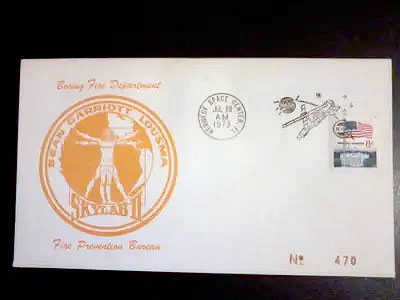 |
Ken Havekotte
Member Posts: 3364
From: Merritt Island, Florida, Brevard
Registered: Mar 2001
|
 posted 11-24-2013 02:34 PM
posted 11-24-2013 02:34 PM
   
Actually, it's not an unknown cover, as a series of them were produced throughout the Apollo/Skylab program era in 1969-73. The special series of "fire cachet covers" at Kennedy Space Center started with the launch of Apollo 12 in November 1969. Another was for Apollo 13's launch in April 1970 that also featured a "13 black cat" sticker as part of the cachet cover design. Both covers were printed in red on top with "God Speed Space Sailors" along with "KSC Fire Service" at bottom. Each, also, had a photo of a Saturn V moon rocket on the pad alongside an official fire department logo. The cover creations were the idea of Bill Killen, a Kennedy Space Center Fire Department (KSCFD) astronaut rescue team veteran. At the time, the KSCFD was operated by The Boeing Company here at Kennedy. Killen's initials, "wdk," were also printed on both of the Apollo cover issues. About 500 covers were produced for each of the Skylab missions from May to November 1973. Each cover was numbered at bottom right with their designated KSC machine launch day cancel applied. - The first Skylab cover for the unmanned SL-1 launch featured a dark blue cachet with the wording "Kennedy Space Center" at top along with "Fire Department" at the bottom of the Skylab program emblem design.
- The second, first manned crew to the orbital Skylab workshop station, contained the SL-2 crew cachet in red with "Astronaut" at top and "Rescue Crew" at bottom.
- Third was the above depicted cover for SL-3 and the final KSCFD cover was for SL-4, printed in green, with "Kennedy Space Center" at top and "Fire Department-Combat Division" printed at bottom.
Though not completely confirmed, I was told by KSCFD veterans that for the SL-2 launch on May 25, 1973, all 500 covers had been stored or carried aboard one of the assigned M-113 astronaut rescue team tank vehicles in support of first manned Skylab mission. On edit: There was also a special Apollo 17 cachet cover, honoring the astronaut rescue team of KSC fire service and military personnel, issued in December 1972. It was reported that less than 200 of the Apollo 12 KSCFD cachet covers were printed, with most sold within the fire department. For Apollo 13, in April 1970, the same cachet cover design had been used for the Apollo 13 launch. But a circular white gummed decal with the number "13" along with a cat image had been placed over the "12" on the Apollo 12 KSCFD cachets. Less than 50 of them were produced for Apollo 13 and postmarked the day of launch, most receiving machine cancels, with perhaps less than 10 of those being hand cancelled. Acquiring a "complete set" of the KSC's fire department cover issues (seven altogether for Apollos 12, 13, 17 and all four Skylabs) would certainly be a challenging feat today. |
bobslittlebro
Member Posts: 218
From: Douglasville, Ga U.S.A.
Registered: Nov 2009
|
 posted 11-24-2013 02:50 PM
posted 11-24-2013 02:50 PM
   
Thanks Ken, great info. |
Ken Havekotte
Member Posts: 3364
From: Merritt Island, Florida, Brevard
Registered: Mar 2001
|
 posted 11-25-2013 08:35 AM
posted 11-25-2013 08:35 AM
   
There is another special KSCFD-issue that my firm produced for the space center fire department, with full authorization by the department to do so (and paid for).It was a 2-color (red and blue) cachet cover in commemoration of KSCFD's 30th anniversary in 1994. About 300 of the covers were printed for the KSCFD. |
Ken Havekotte
Member Posts: 3364
From: Merritt Island, Florida, Brevard
Registered: Mar 2001
|
 posted 12-29-2021 03:15 PM
posted 12-29-2021 03:15 PM
   
Almost 60 years ago, NASA's Kennedy Space Center Fire Department (KSCFD), also at the time from the Cape Canaveral Air Force Station, got underway during the Project Mercury man-in-space program of the early 1960's. The means of evacuating astronauts safely from a burning or otherwise comprised rocket or spacecraft as quickly as possible was a major concern of the space agency.During NASA's Gemini and Apollo programs, the standard means chosen was to use a zip-line in getting astronauts from the launch vehicle pad (or later from the space shuttle) to a concrete bunker from where they would be driven to a safe distance. To meet this unique requirement, NASA put into use the M113 (also M-113) Armored Personnel Carrier (APC) that would allow astronaut rescue crews to get to and from the launch pad scene and evacuate astronauts safely of a launch disaster. Four M113 armored rescuer tracked vehicles were obtained for use at the Cape and Kennedy throughout the 1960s until December 2013. 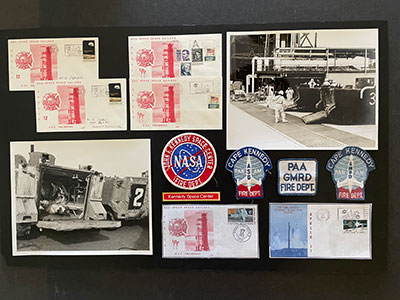 Above are the first space covers issued for NASA's support role of the KSCFD during an Apollo launch to the moon. The first in an Apollo series of three featured a red-printed KSCFD cachet for the Apollo 12 launch in November 1969. Note the initials of "wdk" (William D. Killen), known to his team mates as "Crazy Bill," at the bottom right of this cachet design. Killen reported that most of the 200-printed covers were sold within the fire department. He was one of the original Apollo Astronaut Rescue Team members in October 1968, promoted to driver/operator in 1969, and to rescueman in 1971. Killen resigned three years later and became the fire chief of a fire control district in Orlando, Florida, and authored his first book, along with Lee Starrick, "Kennedy Space Center Fire Department: The First Thirty Years" in 1994. The second cachet cover commemorated Apollo 13's launch in April 1970. A small circular white-gummed label was placed over the "12" on the Apollo 12 cachets that had a scary-looking Halloween cat with the number "13" in order to replace the already "12"-printed number. Less than 50 of the "cat 13" were produced and postmarked at KSC. The final issue in the Apollo moon flights was for the Apollo 17 nighttime launch in December 1972 in honor of the astronaut rescue team of fire service and military personnel. By far, the KSCFD cachet covers are perhaps the rarest of all KSC-related "on base" covers by aerospace companies, contractor organizations, and various support groups and teams. During the Skylab program in 1973-74, America's first manned space station, the first of a registered series of special cachet covers were issued by the KSCFD in May 1973 for the Skylab Orbital Workshop Station. It would be the last Saturn V rocket ever launched. 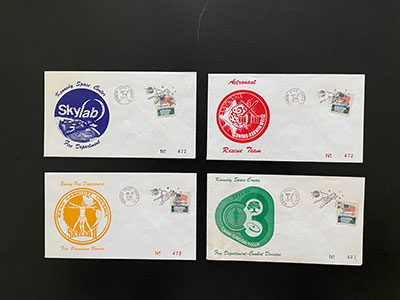 The set of four above, all with serial number 472 of 500 made, honored the KSC Fire Dept. (first cachet in purple), the SL-2 launch with a red-printed cachet for the astronaut rescue team, the orange-colored Boeing Fire Department's Fire Prevention Bureau covers of the SL-3 liftoff in July 1973, and concluding with a green cachet production for the last manned Skylab flight (SL-4) in November that same year for the space center's Fire Department's Combat Division. All four, to the best of my knowledge, are posted with the KSC Skylab slogan die hub machine cancel. The set of four, as with the earlier Apollo 12, 13, and 17 special fire covers, are extremely hard to find and rarely, if ever, seen today. Next up will be a very special assortment or selection of KSC fire support covers that are quite unique. Meanwhile, if any others are known from the Apollo and Skylab programs, even with different serial numbers, let's post them here. |
Bob M
Member Posts: 1802
From: Atlanta-area, GA USA
Registered: Aug 2000
|
 posted 01-02-2022 06:36 AM
posted 01-02-2022 06:36 AM
   
Thanks, Ken, for such an interesting and informative article on these unusual space covers not familiar to many of us - including me. |
Ken Havekotte
Member Posts: 3364
From: Merritt Island, Florida, Brevard
Registered: Mar 2001
|
 posted 01-02-2022 08:30 PM
posted 01-02-2022 08:30 PM
   
Concluding the two-part posting series of KSC Fire Department covers, depicted below are a number of different "carried/located" fire support postal covers. Included in the centered montage is an unusual "carried" signed NASA color glossy photo along with several original or vintage KSCFD cloth patches and personal snapshot-type photographs. To the best of my knowledge, the covers posted here (along with others not seen) are the only such "carried/ located" documented covers known in celebrating the rich history of the KSCFD in such a special way.The display panel presentations mostly pertain to the M113 astronaut rescue vehicles. As mentioned in the the first posting, the latest version of the M113 in use during the shuttle program years was a Vietnam-era armored personnel carrier that offered the astronauts a safe vehicle, a bunker on tracks, to get out of danger. It also offered firefighters heavy protection in case they would have to go into danger to retrieve a shuttle flight crew, and if required, launch pad personnel. 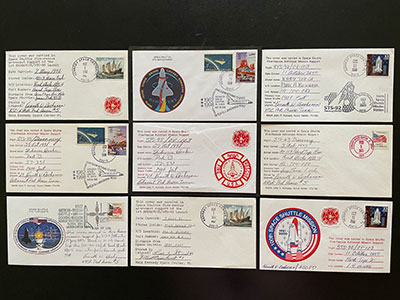 The 10-ton NASA "battle ready" M113 armored rescuer "tank" have reached speeds just over 40 mph and can turn quickly. A highly-trained crew of five to seven would consist of a crew commander, driver, and three to five firefighters and EMTs. Each had to wear a mask, air pack, and a silver/white protection suit with required gear and equipment attached. At the time of a shuttle liftoff, the astronaut rescue team sat in cramped conditions on standby at three different KSC-Pad 39 area locations in case an emergency was called up. While the inside of the M113 is hardly spacious, the firefighters had to curl their legs up tight. Only the driver could see out consistently, looking through four slits facing the pad. The hatches were closed up along with the back door ramp. Most of the firefighters felt the launch more than seeing it because the thunder thoroughly shakes the 15-foot long armored aluminum-alloy carrier. 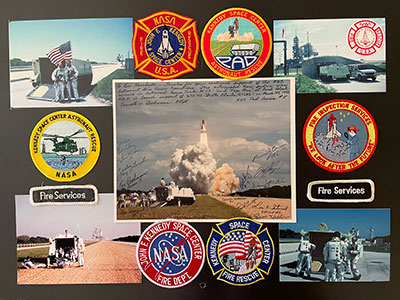 If an emergency occurs before a shuttle launch — the driver, standing nearby the tank — runs in and gets the vehicle moving in seconds, letting another crewman work the lever to lift the back ramp. The astronauts and pad workers have limited air sources, so the rescue teams work to get them to safety in less than 10 minutes from the time they get the rescue call. They constantly trained, adjusted their methods, and response time to shave off seconds. The M113 carried/located covers above represent all of the areas of each support standby vehicle location during a shuttle launch and for some orbiter landing events (see montage below). From reading the filled-in written descriptions by the firemen cover carriers of the astronaut support team, you can see covers were stored inside the M113 vehicles at the Slidewire Bunker at both pads, only 1200 to 1400 feet away from the on-pad shuttle, Road Block A/B-4, 9/10th of a mile distance, and with Hard Top 2, about 1.4 miles distance from the pad to an awaiting M113. 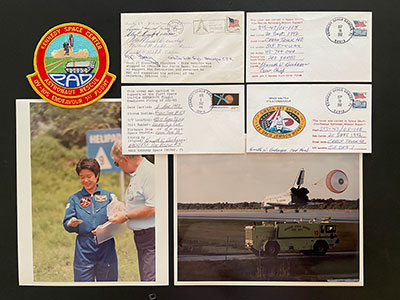 Above: The first Japanese woman to fly in space, Chiaki Mukai of STS-65, receives a special patch by KSC fire and rescue crew chief Lt. Ken Buchanan. The patch, depicted in the montage above with other patches, was awarded to Mukai after she had completed her astronaut training operations in the M113 vehicle. The colorful embroidered patch shows the #1 M113 on duty during a shuttle launch at Pad 39. The patches had been provided by Ken Havekotte of SCCS along with a series of other fire dept. patches that can be seen on the display panels. The flight crew astronauts themselves were required to take a driving course before their shuttle flight into space. One of the astronauts was driving the M113 during his training course down a path carved out near Launch Pad 39B. A row of wild boars (or pigs) moved across the dirt path about 100 yards ahead and the astronaut-driver jerked the levers back so hard the the vehicle came to a skidding halt. The rest of the crew, riding inside as they sat on the thinly padded benches, flew forward instantly, but were okay. As for the pigs, they were fine, as the M113 never touched them. 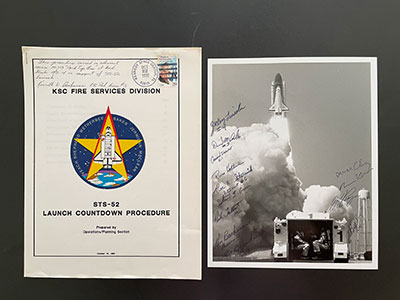 | |
Contact Us | The Source for Space History & Artifacts
Copyright 2022 collectSPACE.com All rights reserved.

Ultimate Bulletin Board 5.47a
|
|

|
 advertisement advertisement

|


















